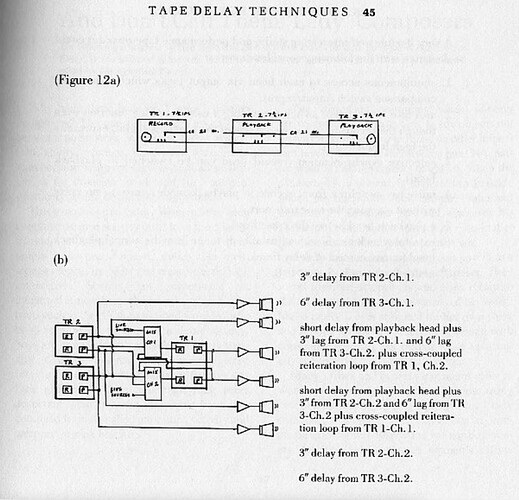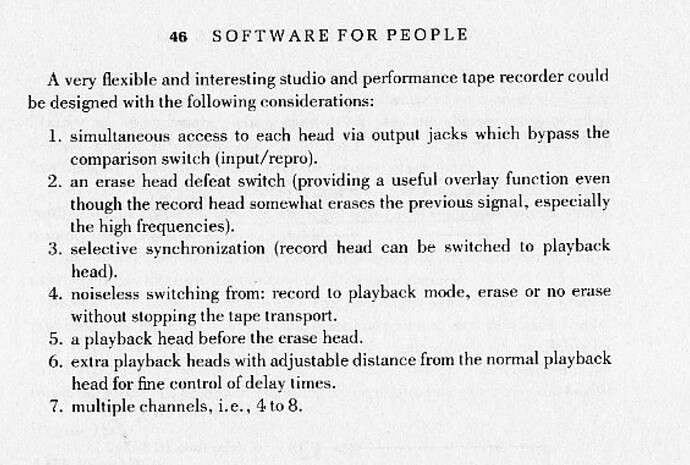There’s a documentary coming about electronic music’s female pioneers, narrated by Laurie Anderson. It includes: Clara Rockmore, Daphne Oram, Bebe Barron, Pauline Oliveros, Delia Derbyshire, Maryanne Amacher, Eliane Radigue, Suzanne Ciani, and Laurie Spiegel.
two nice playlist to listen to before the movie comes out
<3
Sisters With Transistors, after being shown at film festivals, gets a general release this month. Check your local cinemas/streaming services.
E.g.
As I just posted over in What are you Watching?, there’s a preview screening and Q&A streaming on Wednesday 21st: see here for more info. Can’t wait!
fantastic, thanks for the heads up!
I recently found about this documentary. I haven’t seen it, but I want to buy it (not only rent it).
I am interested in trying to create something similar to Pauline Oliveros’s Expanded Insturment System. Or some of her early tape delay experiments. Or a time lag accumulator. Omri’s video on multitap delay with AS Signal Delay seems close. Has anyone else tried to set up something similar?
she taught music at my high school!
Hey yes that sounds amazing! I was actually fortunate to work a little on the EIS up at EMPAC awhile back - super cool stuff.
Feel like that could be super do-able - IIRC the EIS was mostly built around MIDI control of those lexicon rack mount delays, and then later the VST versions of them controlled in Max -
Her book ‘Sounding the Margins’ has some great info + diagrams of the system too if of use! m
Squinky.Labs, that’s cool, I studied with her for a little bit at Mills in 2010, I’m glad she is well remembered 
I was working on an album last year thinking about Brian Eno’s tape loop systems, and was surprised to discover that Pauline had sent him diagrams and explanations of the tape loops that she and Terry Riley had developed for their work, and that’s what he based his on. She was one of those little hidden gears behind a lot of things, I think.
I think I have that book and never read all the way to the end, thanks Matthew, great suggestion. I might do some more tape loop stuff too. I was using Instruo’s Lubadh to try to recreate it, and Jason Lim of Instruo was psyched to hear about it, I just looked up his response and it was:
" The obvious contexts that were in our minds when designing it were guitar players looping as guitar players do and people using it more as a delay effect.
The much more interesting possibilities are precisely what you describe. Using it as a compositional device/instrument a la Oliveros/Eno etc."
But for serenetica, maybe Max or PD could be used, I think that’s how Instruo contributors designed some of their modules, making them in Max first.
But anyway, I think those diagrams in Sounding the Margins are something I’m going to go look up for myself and see if I can recreate them with the tools at hand.
We live in such a remarkable era in terms of the capabilities that we have with the software that lives on our computers, but the possibilities are so endless that it’s very helpful to constrain them into a creatively fertile space of some sort. I feel like Pauline identified some very productive spaces for that, and her lifelong commitment to teaching means that her ideas are particularly well suited to exploration because she was just, year after year, narrowing them down for just that purpose.
I didn’t know that! Very interesting. Any online links where one can read that story?
I had a first stab at it recently, although instead of tape or audio loops I used purely synthesized loops, reading up on how Eno did it. It was a great exercise and it gave me the humilty of realizing that to achieve great musical results with these techniques, it requires a lot of prep work, timing diagrams etc.
I still have some facebook friends who were at mills in the 70’s!
Squinky.Labs That’s awesome, I wouldn’t be surprised if I know some of them. Small world!
LarsBjerregaard I found my copy of Sounding the Margins, it has a diagram of I of IV from Tape Delay Techniques for Electronic Music Composers (1969), and Pauline mentions in the caption that it’s also in her book Software for People.
I found a pdf of Software for People here:
And the diagram that she put in Sounding the Margins is better quality there, I took two screen shots:
Those sound great! Very peaceful and wide open, I feel like my approach got a little cluttered, but I liked the outcome. This is the one I did with the Lubadh, which basically emulates two tape decks, with the extra little feature that the “play head” and the “record head” can be moving at different speeds, so I’m basically inputting very low notes, and then when they play back they’re sped up to a higher pitch, and bounced back and forth between the tape decks, getting a kind of speed up and slowing down quality. It scratched that tape-deck itch, I’d been wanting to do a live tape piece for years.
I did have to go back and clean up some click artifacts that were caused from the play and record heads running over each other at inopportune times. The piece starts out sonorous, then gets a little clangorous, and then it becomes nice again and a bit of back and forth. It’s quite long, but I was also going for that Music for Airports feeling that I liked so much. The input sounds are all a sequenced Plaits, if I recall correctly, and me twiddling the knobs to play the sounds a bit.
I should have written down my settings, but it was like my first week of playing with Lubadh, and I thought I’d have no trouble finding the same settings again in the future, but it was like some magical knob settings. I meant to make more tracks with the technique, but I couldn’t figure out what I’d done again. But I made two more tracks anyway and called it an album. It was only my second one, but so far it’s my favorite.
The second track was also made with the same tool, but this time I recorded guitar and sped it up and slowed it down and then put them all into Simplers in VCV and played them with a fader box, like composing on the 24 track Studer machine at the Mills CCM studio that Maggi Payne insisted everyone learn to use.
Funnily, the last track I can’t remember anything clever to say about it, it was more of a all-in-VCV type of composition, but it might still be my favorite of the three. Then I made a macro photograph of a tiny part of a drawing that a friend had sent me mid-pandemic, and published it as an album through Distrokid. I think your tape pieces would make a nice album too! Actually there are a bunch of great pieces, just taking a listen through your youtube, some really nice sounds. These would be lovely to stream on spotify.
It would be nice to be able to make a vcv rack community playlist just to hear what everybody’s up to from month to month.
@demcanulty . I’m FB friends with Peter Gordon and Jill Kroesen. I think one or both of them were at mills Mack then?
Ohh, cool, yeah, looks like they both studied and collaborated with Bob Ashley. That was a real golden period, I think, a number of the students from that era stuck around and became professors.
Yes, I saw Ashley in maybe the mid 80’s in nyc. I think both of them may have been participating.


